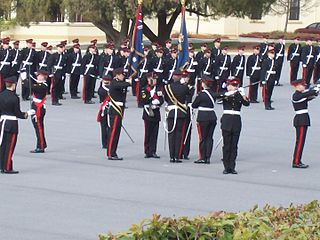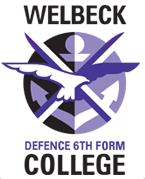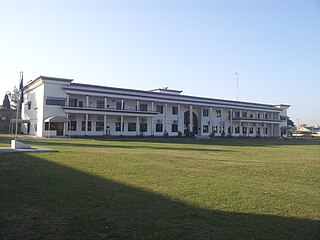
The Bulgarian Army Also called The Bulgarian Armed Forces is the military of Bulgaria. The commander-in-chief is the president of Bulgaria. The Ministry of Defense is responsible for political leadership, while overall military command is in the hands of the Defense Staff, headed by the Chief of the Defense. There are three main branches of the Bulgarian military, named literally the Land Forces, the Air Forces and the Naval Forces.

A military academy or service academy is an educational institution which prepares candidates for service in the officer corps. It normally provides education in a military environment, the exact definition depending on the country concerned.

The Namibian Defence Force (NDF) comprises the national military forces of Namibia. It was created when the country, then known as South West Africa, gained independence from apartheid South Africa in 1990. Chapter 15 of the Constitution of Namibia establishes the NDF and defines its role and purpose as, " ... to defend the territory and national interests of Namibia".
Sergeant First Class (SFC) is typically a senior non-commissioned officer rank, used in many countries.

The Norwegian Armed Forces is the military organization responsible for the defence of Norway. It consists of five branches, the Norwegian Army, the Royal Norwegian Navy, which includes the Coast Guard, the Royal Norwegian Air Force, the Home Guard, and Norwegian Cyber Defence Force as well as several joint departments.
Chief Warrant officer is a senior warrant officer rank, used in many countries.

Russia has a number of military academies of different specialties. This article primarily lists institutions of the Armed Forces of the Russian Federation rather than those of the Soviet Armed Forces.

Welbeck Defence Sixth Form College, formerly named and often referred to as simply Welbeck College, was an independent, selective sixth form college in Leicestershire, England. While run as a sixth form college, the school was an institution of the Ministry of Defence (MoD), and part of the Defence Academy of the United Kingdom.
The Military ranks of Finland are the military insignia used by the Finnish Defence Forces. The ranks incorporates features from Swedish, German, and Russian armed forces. In addition, the system has some typically Finnish characteristics that are mostly due to the personnel structure of the Finnish Defence Forces. The ranks have official names in Finnish and Swedish languages and official English translations. The Swedish forms are used in all Swedish-languages communications in Finland, e.g. in Swedish-speaking units of Finnish Defence Force. The system of ranks in the Swedish Armed Forces is slightly different.

The United Kingdom's Strategic Command (StratCom), previously known as Joint Forces Command (JFC), manages allocated joint capabilities from the three armed services.
The Indian Defence services have established numerous academies and staff colleges across India for the purpose of training professional soldiers in military sciences, warfare command and strategy, and associated technologies.

The Military College of Signals, also known as MCS, is a military school located in Rawalpindi, Punjab, Pakistan. It is a constituent college of the NUST, Islamabad. MCS consists of two engineering departments, EE & CSE. The college puts a strong emphasis on scientific and technological education and research.

The Communications and Information Services Corps (CIS) – formerly the Army Corps of Signals – is one of the combat support corps of the Irish Defence Forces, the military of Ireland. It is responsible for the installation, maintenance and operation of communications and information systems for the command, control and administration of the Defence Forces, and the facilitation of accurate, real-time sharing of intelligence between the Army, Naval Service and Air Corps branches at home and overseas.
A cyber force is a military branch of a nation's armed forces that conducts military operations in cyberspace and cyberwarfare. The world's first independent cyber force was the People's Liberation Army Strategic Support Force, which was established in 2015 and also serves as China's space force. As of 2022, the world's only independent cyber forces are the PLA Strategic Support Force, the German Cyber and Information Domain Service, Norwegian Cyber Defence Force, and the Singapore Digital and Intelligence Service.
The Defence Technical Undergraduate Scheme (DTUS) is a university sponsorship programme for students who want to join the Royal Navy, British Army, Royal Air Force or Engineering and Science branch of the Ministry of Defence (MOD) Civil Service as technical officers after they graduate; Army sponsored students are destined for either the Royal Corps of Signals, Royal Electrical and Mechanical Engineers, Royal Engineers or The Royal Logistic Corps. Students on the scheme are sponsored by the MOD to study accredited technical degree programmes. The aim of DTUS is ‘to educate and develop selected individuals to prepare them for further training and careers as engineer or technical officers in the Armed Forces or as graduate entrants to the MOD Civil Service’.

There existed an evolved system of military education in the Soviet Union that covered a wide range of ages. The Soviet Armed Forces had many tri-service educational opportunities as well as educational institutions for the Soviet Ground Forces, the Air Forces, and the Navy. The Soviet Border Troops, the KGB and the Internal Troops also maintained service academies.

The Military Academy of the University of Defence is a college devoted to military education and career development located in Belgrade, Serbia. The academy forms part of the Serbian higher education system, offering accredited graduate and postgraduate curriculum. It contains a undergraduate military college as well as postgraduate studies.

An officer is a person who holds a position of authority as a member of an armed force or uniformed service.
The ranks and rank insignia of the Soviet Armed Forces between 1955 and 1991 were distinguished by the reorganisation of the Soviet armed forces after the death of Stalin, resulting in changes to ranks, insignia, and uniforms.
The Sri Lankan Armed Forces have established numerous academies and staff colleges across Sri Lanka for the purpose of training professional soldiers in military sciences, warfare command and strategy, and associated technologies.












